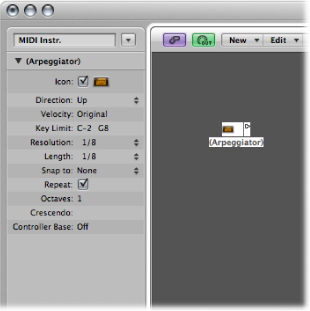Arpeggiator Objects
An arpeggiator object turns chords into arpeggios. It plays the currently held notes—individually—in a selectable pattern (up, down, random, and so on), and at a selectable speed that ranges between whole notes and 768th notes.
Choose New > Arpeggiator (or use the New Arpeggiator key command).

An arpeggiator features parameters for direction, velocity, speed (Resolution), note length, start quantize (Snap), repeats, octaves, and velocity offset (Crescendo). All parameters can be MIDI-controlled in real time, which adds immensely to its versatility.
To use an arpeggiator object, you must place it in the MIDI signal path, and Logic Pro must be open. (For technical reasons, the arpeggiator resets on cycle jumps.)
Typically, you would assign an arpeggiator to an arrange track, and cable its output to an instrument. You can, of course, insert it where needed in the MIDI signal path.
Once set up, you can use the arpeggiator with live MIDI input, or for MIDI region playback. You can also record the output of the arpeggiator by cabling it into the Sequencer Input object. If you do this, be sure you either record to a no output track, or break the arpeggiator’s connection to a MIDI output.
The Arpeggiator Parameter Box
The Parameter box of an arpeggiator contains the following parameters:
- Direction: Determines the direction of the arpeggiated chord. You can choose between the following settings:
- Up: Lowest note to highest note
- Down: Highest note to lowest note
- Up/Down: Up and down; highest and lowest notes repeat
- Auto: Up or down, depending on whether the second chord note arrived before, or after, the first chord note.
- Up/Down2: Up and down; highest and lowest notes don’t repeat.
- Random: Notes play in random order.
- All: All notes play at once (useful when Repeat is on).
- Velocity: Determines the velocity values of the arpeggiated notes. You can choose between the following settings:
- 1 to 127: Fixed velocities
- Original: The velocities of the recorded notes are retained.
- Random: Random velocities between 1 and the original value
- Key Limit: Defines the pitch range for the chord arpeggiation. Any chord notes outside this range are passed directly to the output. This is useful when you want to solo above, or play a bass line below an arpeggiated chord.
- Resolution: Sets the rhythmic note value (the speed in note divisions) of the arpeggio. The None setting deactivates the arpeggiator.
- Length: Defines the length of the arpeggiated notes. The Original setting retains the lengths of incoming (or recorded) notes.
- Snap To: Unless this value is set to None, the arpeggiator waits for Logic Pro to reach the next indicated note division before starting the arpeggio. This is useful for rhythmically synchronizing the arpeggio with other MIDI data.
- Repeat : Selecting this option continues the arpeggio for as long as the chord is held down. If the option is unselected, the arpeggio only plays through once.
- Octaves : The arpeggio can be repeated over 1 to 10 octaves.
- Crescendo: The velocity value set here is added every time the arpeggio is repeated (if the Repeat parameter is turned on).
- Controller Base: All ten parameters of the arpeggiator object can be controlled with MIDI continuous controller events. The Controller Base parameter determines the controller number for the first parameter (Direction). The other parameters are controlled by subsequent controller numbers.
When Controller Base is set to Off, MIDI control of the arpeggiator is disabled.